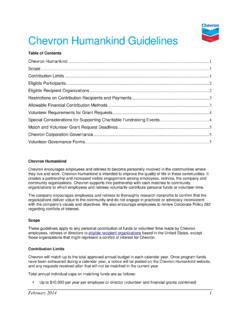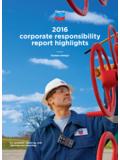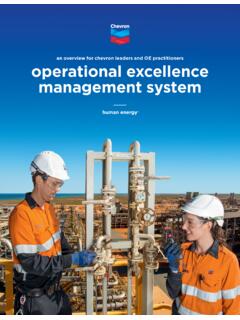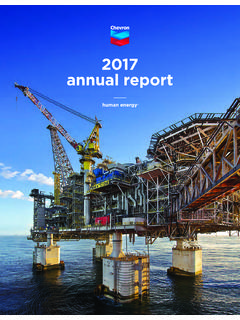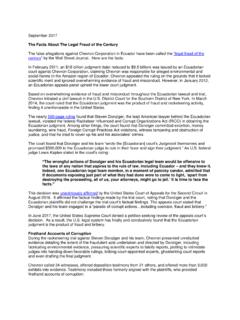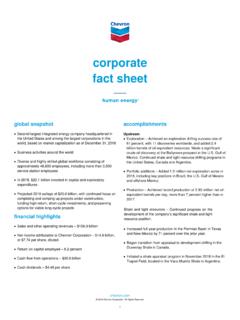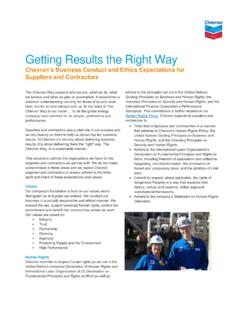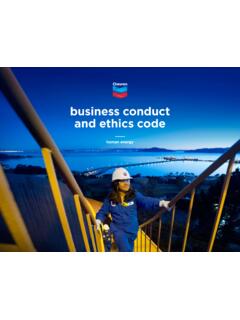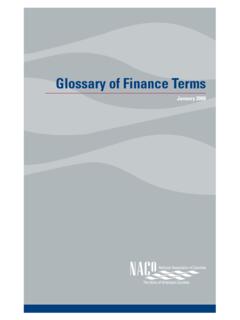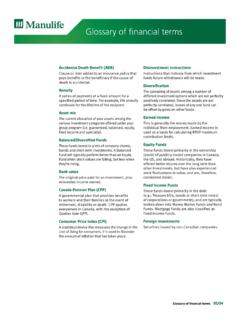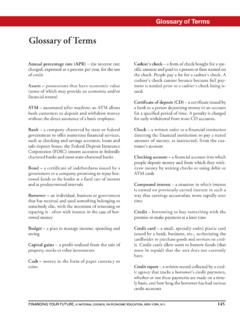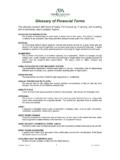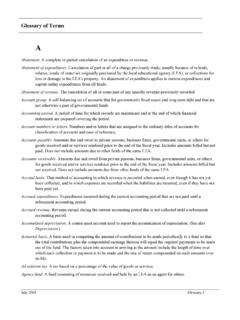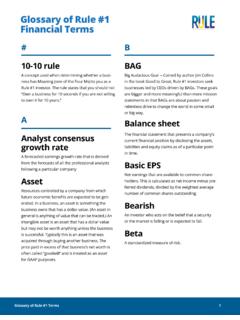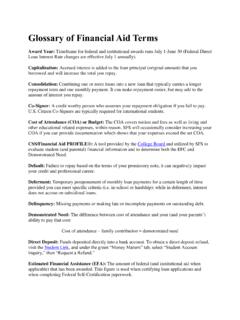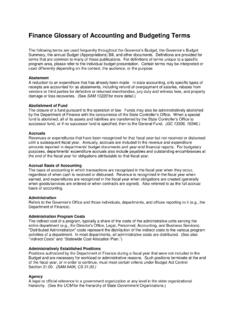Transcription of Glossary of Energy and Financial Terms - Chevron.com
1 50 chevron Corporation 2017 Supplement to the Annual Reportreferenceenergy termsAcreage Land leased for crude oil and natural gas exploration and Specialty chemicals incorporated into fuels and lubricants that enhance the performance of the finished of oil-equivalent A unit of measure to quantify crude oil, natural gas liquids and natural gas amounts using the same basis. Natural gas volumes are converted to barrels on the basis of Energy content. See oil-equivalent gas and Hydrocarbons that are in a gaseous state at reservoir conditions, but condense into liquid as they travel up the well bore and reach surface Drilling, construction and related activities following discovery that are necessary to begin production and transportation of crude oil and/or natural recovery Techniques used to increase or prolong production from crude oil and natural gas Searching for crude oil and/or natural gas by utilizing geological and topographical studies, geophysical and seismic surveys, and drilling of (GTL) A process that converts natural gas into high-quality liquid transportation fuels and other natural gas (LNG) Natural gas that is liquefied under extremely cold temperatures to facilitate storage or transportation in specially designed petroleum gas (LPG)
2 Light gases, such as butane and propane, that can be maintained as liquids while under gas liquids (NGLs) Separated from natural gas, these include ethane, propane, butane and natural gas The volume of natural gas needed to generate the equivalent amount of heat as a barrel of crude oil. Approximately 6,000 cubic feet of natural gas is equivalent to one barrel of crude sands Naturally occurring mixture of bitumen (a heavy, viscous form of crude oil), water, sand and clay. Using hydroprocessing technology, bitumen can be refined to yield synthetic Compounds derived from petroleum. These include: aromatics, which are used to make plastics, adhesives, synthetic fibers and household detergents; and olefins, which are used to make packaging, plastic pipes, tires, batteries, household detergents and synthetic motor of Energy andfinancial termsProduction Total production refers to all the crude oil (including synthetic oil), NGLs and natural gas produced from a property.
3 Net production is the company s share of total production after deducting both royalties paid to landowners and a government s agreed-upon share of production under a PSC. Liquids production refers to crude oil, condensate, NGLs and synthetic oil volumes. Oil-equivalent production is the sum of the barrels of liquids and the oil-equivalent barrels of natural gas produced. See barrels of oil-equivalent, oil-equivalent gas and production-sharing contract (PSC) An agreement between a government and a contractor (generally an oil and gas company) whereby production is shared between the parties in a prearranged manner. The contractor typically incurs all exploration, development and production costs, which are subsequently recoverable out of an agreed-upon share of any future PSC production, referred to as cost recovery oil and/or gas. Any remaining production, referred to as profit oil and/or gas, is shared between the parties on an agreed-upon basis as stipulated in the PSC.
4 The government may also retain a share of PSC production as a royalty payment, and the contractor typically owes income tax on its portion of the profit oil and/or gas. The contractor s share of PSC oil and/or gas production and reserves varies over time, as it is dependent on prices, costs and specific PSC Terms . Refinery utilization Represents average crude oil consumed in fuel and asphalt refineries for the year, expressed as a percentage of the refineries average annual crude unit Crude oil and natural gas contained in underground rock formations called reservoirs and saleable hydrocarbons extracted from oil sands, shale, coalbeds and other nonrenewable natural resources that are intended to be upgraded into synthetic oil or gas. Net proved reserves are the estimated quantities that geoscience and engineering data demonstrate with reasonable certainty to be economically producible in the future from known reservoirs under existing economic conditions, operating methods and government regulations and exclude royalties and interests owned by others.
5 Estimates change as additional information becomes available. Oil-equivalent reserves are the sum of the liquids reserves and the oil-equivalent gas reserves. See barrels of oil-equivalent and oil-equivalent gas. The company discloses only net proved reserves in its filings with the Securities and Exchange Commission. Investors should refer to proved reserves disclosures in chevron s Annual Report on Form 10-K for the year ended December 31, 2017. chevron Corporation 2017 Supplement to the Annual Report 51 referenceResources Estimated quantities of oil and gas resources are recorded under chevron s 6P system, which is modeled after the Society of Petroleum Engineers Petroleum Resource Management System, and include quantities classified as proved, probable and possible reserves, plus those that remain contingent on commerciality. Unrisked resources, unrisked resource base and similar Terms represent the arithmetic sum of the amounts recorded under each of these classifications.
6 Recoverable resources, potentially recoverable volumes and other similar Terms represent estimated remaining quantities that are expected to be ultimately recoverable and produced in the future, adjusted to reflect the relative uncertainty represented by the various classifications. These estimates may change significantly as development work provides additional information. At times, original oil in place and similar Terms are used to describe total hydrocarbons contained in a reservoir without regard to the likelihood of their being produced. All of these measures are considered by management in making capital investment and operating decisions and may provide some indication to stockholders of the resource potential of oil and gas properties in which the company has an interest. Shale gas Natural gas produced from shale rock formations where the gas was sourced from within the shale itself. Shale is very fine-grained rock, characterized by low porosity and extremely low permeability.
7 Production of shale gas normally requires formation stimulation such as the use of hydraulic fracturing (pumping a fluid-sand mixture into the formation under high pressure) to help produce the oil A marketable and transportable hydrocarbon liquid, resembling crude oil, that is produced by upgrading highly viscous or solid hydrocarbons, such as extra-heavy crude oil or oil sands. Tight oil Liquid hydrocarbons produced from shale (also referred to as shale oil) and other rock formations with extremely low permeability. As with shale gas, production from tight oil reservoirs normally requires formation stimulation such as hydraulic oil and gas resources Hydrocarbons contained in formations over very large areas with extremely low permeability that are not influenced by buoyancy. In contrast, conventional resources are contained within geologic structures/stratigraphy and float buoyantly over water. Unconventional resources include shale gas, coalbed methane, crude oil and natural gas from tight rock formations, tar sands, kerogen from oil shale, and gas hydrates that cannot commercially flow without well stimulation.
8 Wells Oil and gas wells are classified as either exploration or development wells. Exploration wells are wells drilled to find a new field or to find a new reservoir in a field previously found to be productive of oil and gas in another reservoir. Appraisal wells are exploration wells drilled to confirm the results of a discovery well. Delineation wells are exploration wells drilled to determine the boundaries of a productive formation or to delineate the extent of a find. Development wells are wells drilled in an existing reservoir in a proved oil- or gas-producing area. Completed wells are wells in which drilling work has been completed and that are capable of producing. Dry wells are wells completed as dry holes, that is, wells not capable of producing in commercial termsCapital employed The sum of chevron Corporation stockholders equity, total debt and noncontrolling interests. Average capital employed is computed by averaging the sum of capital employed at the beginning and end of the flow from operating activities Cash generated from the company s businesses; an indicator of a company s ability to fund capital programs and stockholder distributions.
9 Excludes cash flows related to the company s financing and investing ratio Current assets divided by current ratio Total debt, including capital lease obligations, divided by total debt plus chevron Corporation stockholders Net income attributable to chevron Corporation as presented on the Consolidated Statement of An asset representing the future economic benefits arising from the other assets acquired in a business combination that are not individually identified and separately recognized. Interest coverage ratio Income before income tax expense, plus interest and debt expense and amortization of capitalized interest, less net income attributable to noncontrolling interests, divided by before-tax interest The difference between the cost of purchasing, producing and/or marketing a product and its sales price. Net debt to capital ratio Total debt less the sum of cash and cash equivalents, time deposits, and marketable securities, as a percentage of total debt plus chevron Corporation s stockholders on capital employed (ROCE) Ratio calculated by dividing earnings (adjusted for after-tax interest expense and noncontrolling interests) by average capital employed.
10 Return on stockholders equity Ratio calculated by dividing earnings by average chevron Corporation stockholders equity. Average chevron Corporation stockholders equity is computed by averaging the sum of the beginning-of-year and end-of-year on total assets Ratio calculated by dividing earnings by average total assets. Average total assets is computed by averaging the sum of the beginning-of-year and end-of year stockholder return The return to stockholders as measured by stock price appreciation and reinvested dividends for a period of time.
